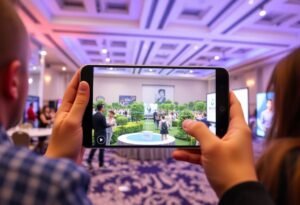The use of Augmented Reality (AR) is revolutionizing product development, offering innovative solutions that enhance creativity, efficiency, and user engagement.
The Role of Augmented Reality in Modern Product Development
Augmented Reality (AR) is becoming increasingly vital in product development processes. By overlaying digital information onto the physical world, AR allows designers and engineers to visualize products before production, thereby reducing errors and development time. With real-time visualization, teams can interact with 3D models of their products, facilitating quicker feedback and more informed decision-making. This innovative technology not only improves collaboration across various departments but also enhances the overall creative process by enabling teams to explore multiple design iterations rapidly and efficiently.
Enhanced Prototyping with Augmented Reality
One of the most significant impacts of AR in product development is its ability to streamline prototyping. Traditional prototyping can be time-consuming and expensive; however, AR enables virtual prototyping, allowing designers to create and modify models in a digital environment before any physical production. This method leads to significant cost savings and faster timelines, as teams are able to iterate designs quickly using virtual simulations. The adoption of AR in prototyping also facilitates better communication with stakeholders, helping to ensure that the final product aligns with expectations from the onset.
Improving User Experience through Augmented Reality
AR significantly enhances user experience by allowing potential customers to visualize products in their own environment before making a purchase. This capability is particularly beneficial for industries such as furniture and home decor, where AR applications let users virtually place items in their homes. By improving customer engagement, businesses can see an increase in conversion rates as buyers feel more informed and confident in their purchasing decisions. Implementing AR technology not only boosts sales but also contributes to building brand loyalty through enhanced user interaction with products.
Training and Development through AR Solutions
Another impactful application of AR is in training and employee development within product development teams. AR can be used to create immersive training modules, giving new employees hands-on experience with products without the need for physical prototypes. This effective training method not only accelerates the onboarding process but also enhances retention of information through experiential learning. Teams trained using AR solutions often exhibit higher productivity and a better understanding of product features, ultimately contributing to a more efficient development cycle.
The Future of Product Development with Augmented Reality
The future of product development lies in the further integration of Augmented Reality technologies. As AR continues to evolve, we can expect more sophisticated applications that leverage machine learning and artificial intelligence to create even more customizable and refined product designs. This trend suggests a shift towards a more consumer-driven approach in product development, where customer feedback is actively integrated into the design process at an unprecedented scale. As companies embrace these innovations, AR will undoubtedly play a pivotal role in shaping the future landscape of product development.
The Broader Implications of Augmented Reality in Innovation
Finally, the implications of AR extend beyond individual businesses. By fostering a culture of innovation and collaboration, AR enhances not only the product development cycle but also accelerates industry advancements as a whole. Businesses that adopt AR are in a better position to respond to market demands and leverage emerging technologies, enabling them to stay ahead of the competition. As we move into a more technology-driven future, the importance of integrating AR into product development cannot be overstated, potentially leading to a new era of innovation.
Disclaimer: The information in this article is for educational purposes only and does not constitute professional advice.





















